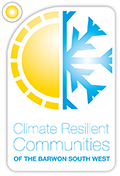The Barwon South West is made up of two catchment regions, the Glenelg Hopkins Region and the Corangamite Region.
The climate of the Glenelg Hopkins Region climate is characterised by hot, dry summers and cool, wet winters, specifically:
- Average maximum summer temperatures are around 22-24 °C near the coast and elevated areas, whilst further inland the temperature range increases to 25-27 °C
- In winter, the average maximum temperatures range from 12-14 °C and frosts are common away from the coast
- Average annual rainfall ranges from 500mm per year (near Lake Bolac) to 910mm (near the Cobboboonee Forest), the winter has a higher winter rainfall
- Key characteristics of this Region include the consistency of rainfall – on average there are 129 days each year where at least 1mm of rain falls.
Climatic trends for this Region during the last decade (1998-2007) are summarised as follows:
- The average annual temperatures in the Region were 0.2 °C warmer than the 30 year average, with summer and winter showing the greatest increase in average temperatures (0.3 °C)
- The average annual number of days over 30 °C increased (by three days)
- The average annual number of days over 35 °C increased (by two days)
- The average number of frosts increased (by three days)
- The average number of cold nights increased by four per year. This may be a result of changes in cloud cover associated with the drought
- The Region’s average rainfall was 10 per cent below the 30 year average
- Decreases in rainfall were greatest in autumn and winter, whilst average summer rainfall showed a small increase
- There were 14 fewer rainy days each year.
The climate for Corangamite Region is characterised by mild to warm summers, specifically:
- The average maximum average temperatures are around 22-24 °C near the coast and in the Otway Ranges, whilst further inland the range increases to 25-27 °C
- In winter, the average maximum temperatures are around 12-14 °C with frosts (which are rare near the coast)
- Annual rainfall average for the Region is 773mm (exceeding 1400mm in parts of the Otway Ranges), generally rainfall is greatest in winter and spring
- On average there are 136 days each year where at least 1mm of rain falls.
Climatic trends for this Region during the last decade (1998-2007) are summarised as follows:
- The average annual temperatures were 0.3 °C warmer than the 30 year average, with summer and winter showing the greatest increases (0.4 °C)
- The average annual number of days over 30 °C increased (by three days)
- The average annual number of days over 35 °C increased (by two days)
- There were ten fewer cold nights and three fewer frosts on average per year
- The Regions average rainfall was 12 per cent below the 30-year average; the decline was greatest in autumn and winter, while average summer rainfall showed a small increase
- There were 14 fewer rainy days each year.
Victoria
Projected climate exposure








